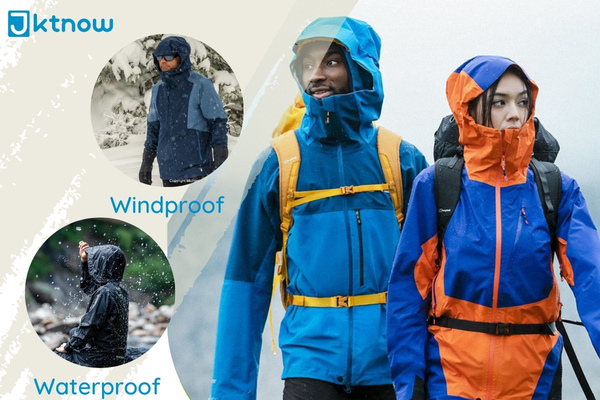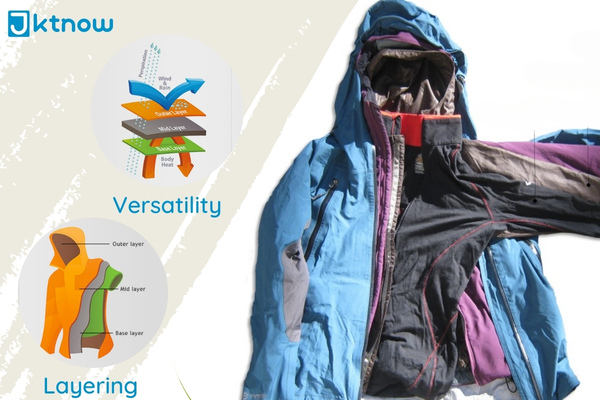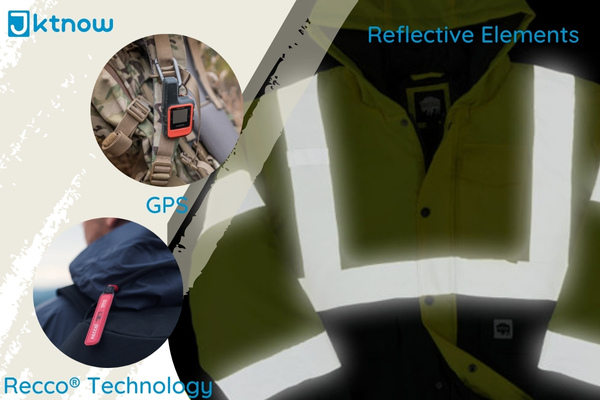Outdoor jackets, like softshell jackets, hardshell jackets, and so on, are more than mere clothing. They are essential companions in exploring the great outdoors. They embody innovation, designed to empower us in our pursuit of diverse activities, offering a range of functions that extend far beyond their core duty of keeping us cozy. Let’s delve deeper into outdoor jackets’ hidden and remarkable functions, revealing how they enhance our experiences and elevate our encounters with the elements.
Weather Protection: The Essential Function of Outdoor Jackets
When it comes to outdoor adventures, weather protection stands as one of the most crucial functions that outdoor jackets fulfill. These jackets aren’t merely about fashion; they’re designed to shield you from the elements and provide a comfortable haven amid Mother Nature’s unpredictable moods. Most hardshell are fully waterproof, windproof, and breathable, ideal for rainy or snowy weather.

Windproof and Cold Resistance
Outdoor jackets are crafted with wind-resistant materials that prevent cold air from penetrating the fabric. It is essential in chilly conditions, as wind chill can rapidly drop your body temperature, leading to discomfort and hypothermia. High-quality jackets feature tightly woven fabrics or specialized membranes that block wind while retaining your body heat and keeping you warm.
Waterproof and Water-Resistant Properties
One of the primary functions of many outdoor jackets is their ability to keep you dry during wet weather. When it is rainy, waterproof jackets have specialized membranes or coatings that create an impenetrable barrier against rain, snow, and sleet. On the other hand, water-resistant jackets repel water to a certain extent but may not be fully waterproof. Both options are essential for outdoor activities, as they ensure you stay dry and comfortable, preventing the chilling effect of wet clothes.
Insulation and Temperature Regulation
Temperature regulation and insulation are crucial functions of outdoor jackets that contribute significantly to keeping the wearer comfortable in varying weather conditions.

Insulation
Insulation in outdoor jackets refers to the material layer that traps and retains body heat to keep the wearer warm. The primary goal of insulation is to create a barrier that prevents heat from escaping, especially in colder environments. Insulated jackets aim to maintain a comfortable body temperature by minimizing heat loss and protecting against the cold. There are three different materials.
Down Insulation: Down jackets use natural down feathers from ducks or geese to provide an exceptional warmth-to-weight ratio. Down traps air effectively, creating an insulating layer that retains body heat. They are lightweight and compressible, ideal for cold and dry conditions.
Synthetic Insulation: Synthetic insulation is made from man-made fibre designed to mimic the insulating properties of down. It performs well even when wet, making it suitable for damp conditions. Synthetic jackets are often more affordable and an excellent choice for wetter environments.
Hybrid Insulation: Some jackets combine down and synthetic insulation to balance warmth and moisture resistance. Designers strategically incorporate down insulation in critical warmth areas and use synthetic insulation in moisture-prone regions for these hybrid jackets.
Temperature Regulation
Outdoor jackets also play a crucial role in temperature regulation, ensuring the wearer stays comfortable and doesn’t overheat during physical activities or in warmer conditions.
Breathability: Modern outdoor jackets are designed with breathable materials that allow moisture (sweat) to escape from the body. Breathability prevents excessive sweating and moisture buildup on the inside of the jacket, which can lead to discomfort and even hypothermia in cold conditions.
Ventilation Features: Many jackets have built-in ventilation features such as underarm zippers or mesh-lined pockets. These allow for increased airflow and heat dissipation when the wearer becomes too warm.
Moisture Wicking: Moisture-wicking technologies draw moisture away from the skin and distribute it across the fabric’s surface. It prevents sweat buildup and helps maintain a dry and comfortable microclimate inside the jacket.
Versatility and Layering: Enhancing Comfort and Adaptability
Outdoor jackets shield you from the elements and provide remarkable versatility through layering. This feature is a cornerstone of modern outdoor apparel, providing wearers with the ability to adapt to changing weather conditions and activity levels.

Adaptability to Weather Fluctuations
Outdoor activities often expose us to unpredictable weather and climate changes. For example, in autumn, the weather is changeable. Versatile jackets are designed to accommodate these fluctuations seamlessly.
Layering allows you to add or remove garments as needed, regulating your body temperature and ensuring optimal comfort.
Base, Insulation, and Shell Layers
Layering typically involves three key components:
A moisture-wicking base layer
An insulating mid-layer
An outer shell for protection against wind and rain
This modular approach empowers you to fine-tune your outfit based on temperature, humidity, and exertion levels.
Temperature Regulation
You can effectively manage your body’s heat retention by incorporating multiple layers. Add or shed layers to maintain a comfortable temperature during different phases of your activity.
Storage Solutions
Outdoor jacket storage solutions provide convenient and accessible ways to carry essential items during outdoor activities. These solutions enhance functionality and keep essential gear close at hand.

Zippered Pockets
Exterior and interior zippered pockets offer secure storage for small items like keys, snacks, or a small wallet.
These pockets prevent items from falling out during movement and protect them from the elements.
Cargo Pockets
More oversized cargo pockets provide ample space for items like maps, gloves, sunglasses, or a compact camera.
These pockets often have additional compartments or dividers for better organization.
Chest Pockets
Positioned on the chest area, these pockets are easily accessible, even when wearing a backpack or harness.
It is ideal for storing items like a GPS device, energy bars, or a small first aid kit.
Sleeve Pockets
These smaller pockets on the sleeves are suitable for storing smaller items like a lift pass, a key card, or a trail map.
Interior Pockets
Hidden interior pockets offer discreet storage for valuable items like a wallet or passport, protecting them from theft or loss.
Mesh Pockets
Mesh pockets are often used for stashing wet items, allowing them to dry while you continue your activities.
Media or Device Pockets
These pockets have openings for headphone cables, allowing you to listen to music or take calls while protecting your device.
Water Bottle Pockets
Some jackets have exterior pouches or sleeves designed to hold a water bottle for easy access and hydration on the go.
Tool Loops or Clips
Jackets designed for technical outdoor activities might feature loops or clips for attaching tools, such as carabiners, ice axes, or climbing gear.
Multi-Purpose Pockets
Some pockets are designed with versatility, serving multiple purposes and accommodating various items.
Outdoor jacket storage solutions actively complement the wearer’s activities and needs, ensuring crucial items are within arm’s reach while minimizing disruptions to the adventure. When selecting an outdoor jacket, consider the type and placement of storage options that align with your intended activities.
Safety Features
Outdoor jackets incorporate safety features to enhance visibility, offer emergency assistance, and boost safety during diverse outdoor activities.

Reflective Elements
Many outdoor jackets feature reflective strips or patches strategically placed on the jacket to enhance visibility in low-light conditions. When it’s dark outside, these reflective elements make the wearer more visible to others, such as drivers, cyclists, or fellow hikers.
LED Lights
Some advanced jackets have built-in LED lights that can be turned on for increased visibility. These lights can be handy during nighttime activities or emergencies.
Whistles
Jackets designed for outdoor adventures often have integrated emergency whistles. You can use these whistles to signal for help in emergencies or communicate with others when you’re out of sight.
GPS or Communication Pockets
In highly specialized outdoor jackets, particularly those crafted for backcountry exploration, designers may incorporate pockets to securely hold GPS devices or communication tools such as walkie-talkies or satellite communicators.
Reflective Zippers and Pulls
In addition to reflective patches, jackets might have reflective zippers and pull. These small details add to visibility and safety.
SOS Signaling
Some advanced outdoor jackets come with discreet SOS signaling features, such as reflective patterns or color-coded tabs communicating distress signals.
Recco® Technology
Recco® reflectors are a passive avalanche rescue system that can be integrated into outdoor clothing, including jackets. These reflectors can be detected by search and rescue teams equipped with Recco® detectors, aiding in locating individuals in case of avalanches or emergencies.
Specialized Functionality
Indeed, specialized functionality in outdoor jackets refers to features and design elements tailored to specific outdoor activities. These features enhance the performance, comfort, and safety of individuals engaged in mountaineering, hiking, and more activities.

Mountaineering Jackets
Harness-Compatible Design: Allows wearing a climbing harness comfortably over the jacket.
Reinforced Shoulders and Elbows: Withstand abrasion from backpack straps and gear.
Extended Back Length: Ensures coverage even when reaching overhead.
Wire Rimmed Hoods: Maintain visibility while wearing a helmet or climbing gear.
Ice Axe Loops: Securely carry ice tools and equipment.
Hiking and Trekking Jackets
Lightweight and Packable: Easily foldable for space-efficient packing during hikes.
Ventilation Panels: Help regulate body temperature during uphill climbs.
Multi-Functional Pockets: Storage for maps, compasses, snacks, and small gear.
Adjustable Cuffs and Hems: Customize the fit to prevent drafts and keep warm.
DWR Coating: Repels light rain and moisture while staying breathable.
Rain Jackets
Fully Taped Seams: Prevent water from seeping through the stitching.
Adjustable Hood with Visor: Shields the face from rain and wind.
Waterproof Zippers: Keep water out even in heavy downpours.
Underarm Ventilation: Enhances breathability while staying rain-resistant.
Quick-Drying Materials: Ensures comfort even after getting wet.
Conclusion
The functions of outdoor jackets go far beyond traditional jackets, including durability, adaptability, and even environmental responsibility. Whatever the jacket for men, women, and kids, there are many functional jackets. If you want to know more details about jackets or get the right jacket, please get in touch with us.
Get High-Quality Custom Outdoor Jackets From Jktnow!
Ready to explore the incredible functions of outdoor jackets firsthand? Look no further than Jktnow! As a leading professional outdoor jacket manufacturer and wholesaler based in China, we offer various outdoor jackets tailored to your needs. Whether you are searching for custom designs, logos, specialized materials, or affordability without compromising quality, Jktnow has you covered.
Elevate your outdoor adventures and experience the functions of outdoor jackets like never before. Contact us today to embark on your journey with the perfect outdoor jacket by your side – because at Jktnow, we’re committed to enhancing your outdoor experience!
FAQs
Q1. How do I choose the right outdoor jacket for my needs?
Choosing the right outdoor jacket depends on the intended use, climate, and personal preferences. Consider factors such as waterproofing, insulation, and fit to make an informed decision.
Q2. What’s the difference between a hardshell and a softshell jacket?
Hardshell jackets are designed for extreme weather conditions and offer superior protection against rain and wind. Softshell jackets are more flexible and breathable, making them suitable for active pursuits in milder weather.
Q3. Can I use the same outdoor jacket for different seasons?
Some versatile outdoor jackets can be used in multiple seasons with appropriate layering. However, for extreme cold or hot conditions, you may need specialized jackets designed for those seasons.
Q4. How do I maintain and clean my outdoor jacket to prolong its life?
Follow the manufacturer’s care instructions, which usually involve using a mild detergent and avoiding fabric softeners. Regularly cleaning and reproofing your jacket can help maintain its performance.
Q5. Are there outdoor jackets specifically designed for certain activities like skiing or mountaineering?
Yes, many outdoor jackets are tailored for specific activities and include helmet-compatible hoods for skiing or harness-friendly designs for climbing. Choose a jacket that suits your preferred outdoor pursuits.

